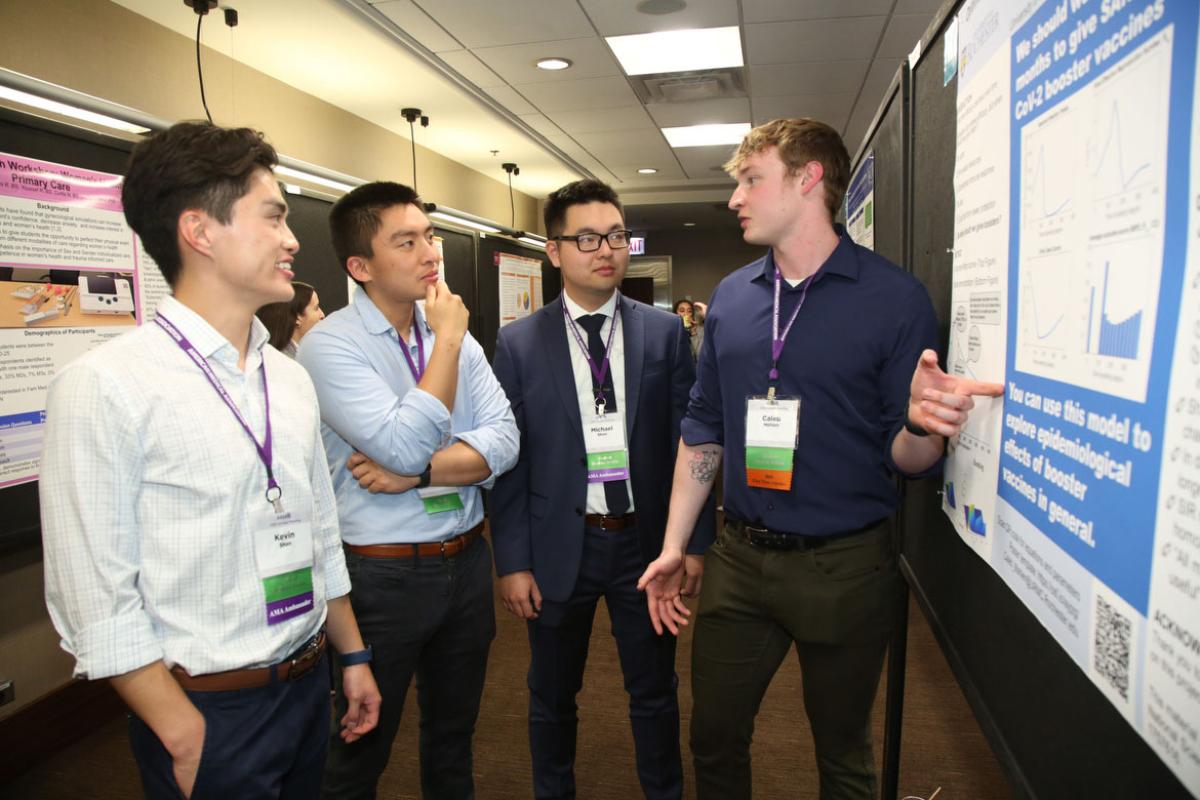On this page:
- Things to know first
- Writing personal statements
- Highlighting organized medicine activities in your residency application
- Preparing a curriculum vitae
- Requesting recommendation letters
- After applying
After deciding which physician specialty to pursue, it is time to prepare and send a residency application and supporting documents to your desired residency programs.
The Electronic Residency Application Service (ERAS) is used by most residency programs to manage this process. ERAS is available to all U.S. medical students through their respective dean’s offices. For international medical graduates (IMGs), it is available through the Educational Commission for Foreign Medical Graduates (ECFMG), a division of Intealth that acts as the designated dean’s office for foreign students.
It is worth noting that a handful of specialties including ob-gyn, ophthalmology and plastic surgery will have different application processes. To fully understand those application processes, it’s best to reach out to your medical school’s office of student affairs.
The AMA helps medical students master the residency-application process so you can make the right decisions about your career, prepare for a knockout interview, explore residency opportunities—all so you can successfully match.
As applicants embark on the residency-selection process, FREIDA™, the AMA Residency and Fellowship Database®, is a comprehensive resources that includes information on more than 13,000 Accreditation Council for Graduate Medical Education-accredited residency programs, and offers a streamlined user experience.
Dive deeper:
- Residency match made simple: From M4 to PGY-1 in 6 steps
- 4 tricks to a successful residency program search
Things to know first
Prior to applying, you are responsible for determining whether a program of interest uses ERAS, what the deadline is for submitting an application and the eligibility requirements for that program. Start the process early so you have sufficient time to resolve any problems you may encounter.
Once you have contacted your dean’s office, the rest of the application process can be completed online through ERAS. Application fees to use ERAS are based on the number of programs applied to per specialty. Remember that once the total fee has been paid, it is not refundable. For IMGs, an additional application fee is required. If you’re trying to budget for application fees, calculate those expenses with FREIDA’s residency calculator.
When choosing the number of programs you would like to apply to, use a systematic approach that takes all relevant decision-making factors into consideration. If location is significant to your decision, use that factor to narrow down your top- and middle-tier choices.
Dive deeper:
- Applying for residency programs: Fourth-year med students' essential checklist
- The top questions to ask before you submit your residency application
- When it comes to submitting residency applications, cast a wide net
Writing personal statements
A personal statement is a written description or essay of your achievements, accomplishments and interest in the educational program or job that you are applying for. It is an important part of your residency application process.
You should write a different personal statement for each physician specialty for which you are applying. Give yourself time to solicit feedback on your statements from advisers and instructors and make suggested revisions. The individuals you select to review your statement should be from various backgrounds, both medical and nonmedical, and should include someone from the specialty to which you are applying.
Your reviewers should be skilled not only in writing but also in providing objective, high-quality and detailed feedback. Your statement should flow smoothly while conveying your reasons for choosing a career in that specialty. Your passion, work ethic, personality and desire to make a positive contribution to the field should be apparent to the reader. Strive to underscore your interest in the specialty by including relevant life experiences, clinical work and research that make your statement stand out and convey your unique qualities.
Dive deeper:
Highlighting organized medicine activities in your residency application
Involvement in organized medicine—especially involvement in AMA and the Medical Student Section—helps medical students become better physicians.
“… I’ve found that residents who have meaningfully engaged in advocacy and organized medicine as medical students are consistently some of the strongest in clinical decision-making, critical reasoning, adaptability, and in how they communicate with patients.
“That’s why I often urge my colleagues who are tasked with evaluating residency applications to strongly consider the applicant’s experience in health care advocacy and leadership, and especially their involvement in the AMA or state medical associations and national specialty societies.”
—Michael Suk, MD, chair of the AMA Board of Trustees
Read the entire Leadership Viewpoint
But how can medical students demonstrate the value of their experiences in organized medicine to residency program directors? Consider using the “Selected Experiences” portion of the ERAS residency application to succinctly tell the story of your involvement and success in organized medicine using this simple template.
Template
I served as [insert position title] of the AMA Medical Student Section, where I was responsible for [insert short description of responsibilities]. Personal successes from this experience include [insert personal successes].
Example
I served as chair of the AMA Medical Student Section from 2023 to 2024, where I was responsible for leading our eight-member elected governing body, which included facilitating strategic planning, chairing meetings, and collaborating with AMA management and other stakeholders to advance the Section’s priorities and represent the views of over 50,000 student members of the AMA. Personal successes from this experience include developing my leadership skills, ensuring better student representation at national meetings, and successfully advocating for policies associated with LGBTQ+ health, maternal health, and health equity related issues.
Preparing a curriculum vitae
A curriculum vitae (CV) is a chronological overview of accomplishments and is used by professionals in the fields of academia, medicine, teaching and research. You will be asked throughout your career for a copy of your CV, so take the time to prepare a quality document that accurately reflects your achievements.
For residency applicants, the CV is digital. It is, generally, submitted through ERAS, or the application service used by the specialty to which you are applying. Because of that, you are likely going to be copying and pasting your CV into fields in a digital form. That does take away some of the potential formatting headaches, but that doesn’t mean you should not be double-checking your application.
Dive deeper:
- 6 keys to creating a medical student CV that sets you apart
- How to tell a cohesive story on your residency application
- The do’s and don’ts of CV writing for residency applicants
Requesting recommendation letters
Depending on the specialty and the programs to which you are applying, the request for letters of recommendation can vary slightly. Be sure to consult specific program requirements for letters of recommendation before you seek out individuals to write them on your behalf.
Experts on the Match say it’s best to avoid having residents write recommendations; letters written from attending physicians have more impact in an application. That said, don’t just pick anyone. You should choose individuals who know you well enough to write a strong letter on your behalf and can discuss your specific qualities and experiences rather than writing in generalities. It may be useful to provide them with examples of your accomplishments and skills that they can use as supporting material for the letter. It is also recommended that you provide all letter writers with a copy of your most current CV and personal statement.
Although the required number of letters of recommendation can vary by program, most have a maximum of four letters. Try to obtain at least one letter from a faculty member on an advanced rotation in the specialty to which you are applying. For those applying to primary care residency programs, in addition to acquiring letters from practicing physicians in that specialty, get letters from faculty members on different specialty rotations that relate to your future scope of practice.
Medical students with pertinent experience outside the traditional clinical arena—such as research, professional society participation or special clinical experiences through volunteer or international work—should also consider professionals from those areas as potential recommendation letter writers. Through ERAS, you can control which letters go to which programs.
Dive deeper:
- How to secure letters of recommendation that sparkle
- Meet Your Match: Getting standout letters of recommendation
- Application tips, tricks from doctor who oversees the Match
After applying
Once a completed application has been sent, the waiting begins. Typically, you should receive responses regarding interviews within four to six weeks. If you don’t, you can contact your residency-application service to inquire about the status of the application.
The next step in the process is residency interviews which will take place virtually for the vast majority of specialties.
Dive deeper:
- What residency applicants should know before interviews
- Meet your Match: How to nail the virtual interview
- 5 things to do if you aren’t getting enough residency interviews
- Meet your Match: How to manage residency interview invites




